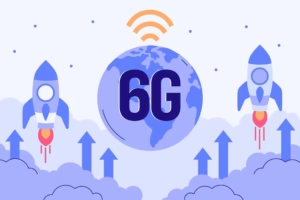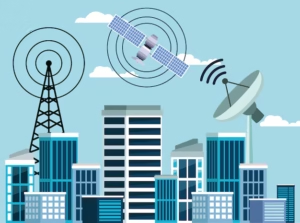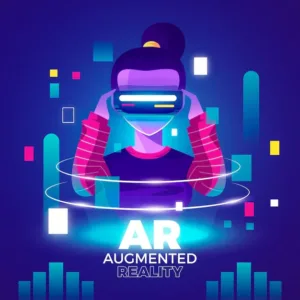6G Data: Everything You Need to Know About the Next Revolution in Connectivity

Table of Contents
Introduction:
We are living in a time of rapid technological evolution, and mobile connectivity is at the forefront of this revolution. While 5G is still being rolled out globally, the tech industry is already looking ahead to the next big thing: 6G data. Imagine speeds 100 times faster than 5G, virtually zero latency, and the ability to connect billions of devices seamlessly—this is the promise of 6G.
In this blog, we’ll dive deep into what 6G is, how it will work, what makes it different from 5G, and when we can expect it to hit the market. Whether you’re a tech enthusiast or someone eager to understand how future technologies will impact daily life, this blog has everything you need to know about 6G.

What is 6G?
6G refers to the sixth generation of wireless communication technology, the next step after 5G. While 5G is already enhancing speeds, latency, and connectivity across various industries, 6G is expected to take these capabilities to an entirely new level. It’s not just about faster speeds or improved connectivity, but about transforming the very way we interact with technology.
6G will make smart devices even smarter, enable more real-time applications, and bring advanced AI into the fold. It’s poised to connect everything—from our cars to homes, health devices, and even entire cities—in a seamless, ultra-fast network.
The goal of 6G is to push the limits of speed, bandwidth, and overall performance, with capabilities far beyond what we can imagine today. 6G data will not just be about mobile phones, but also about the next-generation applications in fields like telemedicine, autonomous vehicles, IoT (Internet of Things), virtual reality (VR), and augmented reality (AR).
What Technology Will 6G Use?
The 6G network will be powered by several cutting-edge technologies that will lay the foundation for blazing fast speeds, reliable connectivity, and intelligent networks. Here are some of the key technologies that will make 6G a reality:

1. Terahertz (THz) Waves
- One of the key technologies that 6G will utilize is terahertz waves. These are extremely high-frequency radio waves that can transmit large amounts of data at lightning speed. Unlike 5G, which uses millimeter waves, terahertz waves can carry more data and cover longer distances, making them a crucial element of 6G. These ultra-high frequencies will allow 6G to deliver download speeds of up to 1000 Gbps (1 Tbps), enabling near-instantaneous data transfer.

2. Artificial Intelligence (AI)
- Artificial intelligence will play a crucial role in 6G by optimizing networks, improving resource management, and making intelligent decisions about data routing. AI-powered networks will be able to automatically manage traffic and adjust network performance, ensuring maximum efficiency.

3. Quantum Communication
- Quantum communication will be used to ensure that 6G networks are secure and immune to hacking. Quantum encryption will make data almost impossible to intercept or decrypt, offering unbreakable security for users and businesses alike.

4. Advanced Satellite Networks
- With 6G, satellite communication will become more prevalent. These satellites will help deliver global, ubiquitous coverage, even in remote and rural areas, ensuring that people in all corners of the world will have access to fast, reliable internet.

5. Holographic and Augmented Reality (AR) Technologies
- 6G will take AR and VR to new heights by supporting ultra-low-latency, immersive experiences. Imagine attending a virtual meeting in 3D, or shopping online and trying on clothes virtually through holographic technology—this will all be possible with 6G.
How is 6G Different from 5G?
While 5G is impressive, 6G is expected to provide faster speeds, lower latency, and the ability to support more devices. Let’s break down the main differences:

1. Blazing Fast Speeds
- 5G networks already promise download speeds of up to 10 Gbps, but 6G will go beyond this, with speeds potentially reaching 1000 Gbps or even 1 Tbps. This will enable instantaneous downloads, uninterrupted 8K streaming, and seamless cloud-based gaming without lag.
2. Unmatched Reliability
- With 5G, the latency is already low (around 1 ms), but 6G is expected to offer virtually zero latency. This means that data transfer and communications will happen in real time, with no noticeable delay, which is especially important for applications like autonomous vehicles or remote surgery.
3. Handling More Devices, More Data
- The number of connected devices is growing exponentially with the rise of the Internet of Things (IoT). 6G will support 10 million devices per square kilometer, compared to 5G’s 1 million devices. This will allow cities to become smarter, with everything from streetlights to home appliances seamlessly connected to the network.
4. Advanced Security
- With quantum encryption, 6G will offer unbreakable security, making it nearly impossible for hackers to access your data. This will protect sensitive information and ensure that businesses and individuals can use the network with confidence.
When Is 6G Going to Come Out?
Although 5G is still being rolled out in many parts of the world, 6G is already being researched and developed by leading tech companies, universities, and research institutions. 6G networks are expected to start rolling out around 2030, but the exact timeline remains uncertain. Researchers are already laying the groundwork for 6G by exploring new technologies, including terahertz waves, quantum computing, and AI-based networking.
The early stages of 6G research are focused on developing the infrastructure and understanding how new technologies will work together to create the next generation of connectivity. By the time it’s ready for global implementation, 6G will likely revolutionize not only telecommunications but also industries like healthcare, education, transportation, and more.
How Will 6G Impact Different Industries?
The deployment of 6G technology will have a profound impact on several key industries:
1. Healthcare
- 6G will enable real-time remote surgeries and improved telemedicine by providing low-latency, high-bandwidth networks. Doctors will be able to diagnose patients remotely and perform surgeries with advanced robotics.
2. Transportation
- With 6G, autonomous vehicles will be able to communicate in real-time with other vehicles and infrastructure, ensuring safer roads and efficient traffic management. This will pave the way for self-driving cars, drones, and smart traffic systems.
3. Entertainment
- Holographic entertainment will become a reality with 6G, where users can watch live sports or concerts in 3D from their homes. Augmented reality will allow gamers to interact with the real world in a more immersive way, and virtual reality (VR) will bring gaming and media to new heights.
4. Smart Cities
- 6G will be the backbone of smart cities, where everything from streetlights to waste management is connected. IoT devices will make urban living more efficient and sustainable, with real-time data to optimize traffic, energy use, and public services.
Conclusion:
The future of mobile technology is incredibly exciting, and 6G data is set to transform the world as we know it. With blazing fast speeds, unmatched reliability, and the ability to connect billions of devices, 6G will open the door to a new world of possibilities, from autonomous vehicles to real-time health monitoring and beyond.
While 6G won’t be here for another few years, the groundwork is already being laid, and it promises to be a game-changer in every aspect of our lives. So, whether you’re a tech enthusiast, a business leader, or simply curious about the future of connectivity, now is the time to start paying attention to the evolution of mobile networks—because the 6G revolution is just around the corner!
~By KeniElectronics








Add comment